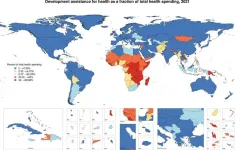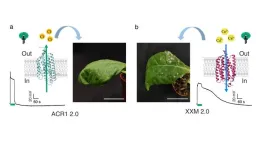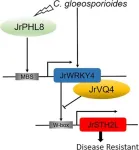(Press-News.org) Slow growth in health sector spending is projected in Sub-Saharan Africa as reported in a study published in the open access journal, PLOS Global Public Health. The decline is expected to continue to 2050, according to Angela E Apeagyei and researchers at the Institute for Health Metrics and Evaluation, University of Washington, Seattle, and is driven by tepid growth in the share of government spending that is allocated to health and reductions in development assistance for health.
The research analyses data from databases covering development assistance for health, global health spending and gross domestic spending (GDP) per capita as well as an expected health spending database which provides projected health spending data to 2050. It finds that except for central and eastern Europe and Central Asia, around the world total health spending is expected to rise as a share of GDP, but in Sub-Saharan Africa (except in southern sub-Sahara Africa) it is expected to decrease.
Beyond the challenge of a low prioritization of the health sector in the government budget, another major driver of this decline is a reduction in development assistance for health. The Millennium Development Goals led to a period of growth in health funding, and development assistance for health grew on average 11.1% annually from 2000 until 2015. It has since dropped to just 4.6% and was particularly hit by the global economic issues caused by the COVID pandemic and subsequent economic shocks such as the war in Ukraine. Although government spending on health in Sub-Saharan Africa has increased, and is expected to continue to rise, the gap left by decreases in development assistance will not be met.
Without improvements, this trend will pose a significant challenge to meeting health-related Sustainable Development Goals and the African Union’s Africa Agenda 2063. The authors hope that their analysis will help policymakers understand future health spending patterns and can translate the insights into tangible actions that can help navigate the region’s complex economic and health challenges.
The authors add: “For countries in sub-Saharan Africa, the projected growth in donor and government funding for health is expected to be significantly lower compared to countries in other regions. This worrying trend underscores the need to prioritize innovative financing strategies to strengthen health systems in line with the region's economic growth and the broader health needs of its population.”
#####
Press-only preview: https://plos.io/3SQcEmu
In your coverage please use this URL to provide access to the freely available article in PLOS Global Public Health: https://journals.plos.org/globalpublichealth/article?id=10.1371/journal.pgph.0003433
Contact: Angela Apeagyei, amicah@uw.edu
Image Caption: Fig 2. Proportion of health spending that is development assistance, 2021.
Image Credit: Apeagyei et al., 2024, PLOS Global Public Health, CC-BY 4.0 (https://creativecommons.org/licenses/by/4.0/)
Image Link: https://plos.io/3SV6Tnx
Citation: Apeagyei AE, Lidral-Porter B, Patel N, Solorio J, Tsakalos G, Wang Y, et al. (2024) Financing health in sub-Saharan Africa 1990–2050: Donor dependence and expected domestic health spending. PLOS Glob Public Health 4(7): e0003433. https://doi.org/10.1371/journal.pgph.0003433
Author Countries: Ghana, United Kingdom, United States
Funding: AEA, BLP, NP, JS, GT, YW, WW, AW, and JLD were funded by the Bill & Melinda Gates Foundation. YZ and JN received no specific funding for this work. The funder of the study had no role in study design, data collection, data analysis, data interpretation, or writing of the report.
END
Lackluster prioritization of the health sector in government spending and dwindling donor contributions drive slow growth in health spending in Sub-Saharan Africa
2024-08-28
ELSE PRESS RELEASES FROM THIS DATE:
People experiencing relatively mild cases of mental ill-health may be perceived differently by others depending on whether or not diagnostic labels are provided
2024-08-28
Diagnostic labels for people experiencing what some consider to be relatively milder forms of mental-ill health may affect how others perceive them for better and worse, according to a study published August 28, 2024 in the open-access journal PLOS Mental Health by Nick Haslam from the University of Melbourne, Australia, and colleagues.
In recent years, there’s been a general shift to increased diagnoses of mental ill-health. Here, Haslam and colleagues investigate the implications of diagnosing individuals presenting with ...
Unhealthy commodities—like alcohol and social media—are connected with poor mental health
2024-08-28
“Unhealthy commodities” such as tobacco, alcohol, ultra-processed foods, social media, and fossil fuels, as well as impacts of fossil fuel consumption such as climate change and air pollution are associated with depression, suicide, and self-harm, according to a study published August 28 by Kate Dun-Campbell from the London School of Hygiene & Tropical Medicine, and colleagues.
Globally, around one out of every eight people currently live with a mental health disorder. These disorders—including depression, suicide, anxiety, and other diseases and disorders—can have many underlying causes. ...
Bacterial cells transmit memories to offspring
2024-08-28
Bacterial cells can “remember” brief, temporary changes to their bodies and immediate surroundings, a new Northwestern University and University of Texas-Southwestern study has found.
And, although these changes are not encoded in the cell’s genetics, the cell still passes memories of them to its offspring — for multiple generations.
Not only does this discovery challenge long-held assumptions of how the simplest organisms transmit and inherit physical traits, it also could be leveraged for new medical applications. For example, researchers could circumvent antibiotic resistance by subtly tweaking a pathogenic ...
Dogs understand words from soundboard buttons, study reveals
2024-08-28
If you’ve seen those viral social media videos of dogs using soundboard buttons to “talk,” you’re not alone. These buttons have taken the pet world by storm, leading to impressive and sometimes seemingly miraculous feats shared across platforms like TikTok and Instagram. But are these dogs truly communicating, or are they just responding to cues from their owners?
Now, a new study published in PLOS ONE – by researchers from the University of California San Diego and other institutions – ...
New pancreatic cancer treatment proves effective in shrinking, clearing tumors
2024-08-28
Researchers at the University of Massachusetts Amherst and UMass Chan Medical School have demonstrated in mice a new method to combat pancreatic cancer. The study, published in Science Translational Medicine, outlines the synergistic effects of a novel nanoparticle drug-delivery system to activate an immune pathway in combination with tumor-targeting agents.
Pancreatic ductal adenocarcinoma (PDAC) is the most common form of pancreatic cancer. With a dismal,13% five-year survival rate, it is the third leading cause of cancer deaths.
One major ...
Study reveals isolation, endogamy and pathogens in early medieval Spanish community
2024-08-28
An archaeogenetic study sheds new light on the isolated medieval community Las Gobas in northern Spain. Besides isolation and endogamy, the researchers have also identified the variola virus which can offer a new explanation on how smallpox entered Iberia.
Researchers from Sweden and Spain have conducted a comprehensive archaeogenetic study on a community that lived on the border between the northern Christian kingdoms and Al-Andalus during the early Medieval period. This dynamic era, especially ...
Chromosome copying errors pinpointed in embryo development
2024-08-28
A new discovery by researchers at the RIKEN Center for Biosystems Dynamics (BDR) in Japan upends decades of assumptions regarding DNA replication. Led by Ichiro Hiratani and colleagues, the experiments published August 28 in Nature show that DNA replication in early embryos is different from what past research has taught, and includes a period of instability that is prone to chromosomal copying errors. As failed pregnancies and developmental disorders are often related to chromosomal abnormalities the findings could impact the field of reproductive medicine, perhaps leading to improved methods of in vitro fertilization (IVF).
During embryogenesis, ...
A cellular community in the brain drives Alzheimer’s disease
2024-08-28
NEW YORK, NY (Aug. 28, 2024)--An analysis of more than 1.6 million brain cells from older adults has captured the cellular changes that occur in the early stages of Alzheimer’s disease, potentially revealing new routes for preventing the most common cause of dementia in older individuals.
The study also identified a second community of cells that drives the older brain down a different path that does not lead to Alzheimer’s disease.
“Our study highlights that Alzheimer’s is a disease of many cells and their interactions, not just a single type of dysfunctional ...
Plant signaling pathways decoded
2024-08-28
When it comes to survival, plants have a huge disadvantage compared to many other living organisms: they cannot simply change their location if predators or pathogens attack them or the environmental conditions change to their disadvantage.
For this reason, plants have developed different strategies with which they react to such attacks. Such reactions are usually triggered by certain signals from the environment. As has long been known, the intracellular calcium concentration plays an important role in the processing of these signals.
However, in addition to changes in the cytoplasmic calcium level, changes in the cell's ...
Fighting fungal foes: Walnut's genetic armor against anthracnose revealed
2024-08-28
A pivotal study has pinpointed a gene module crucial for enhancing walnut trees' resistance to anthracnose, a widespread fungal disease threatening the walnut industry. The research reveals how the JrPHL8-JrWRKY4-JrSTH2L module regulates disease defense, opening up new opportunities for breeding resistant walnut varieties and promoting sustainable cultivation practices.
Anthracnose, caused by Colletotrichum gloeosporioides, poses a significant threat to walnut production, causing severe losses ...










